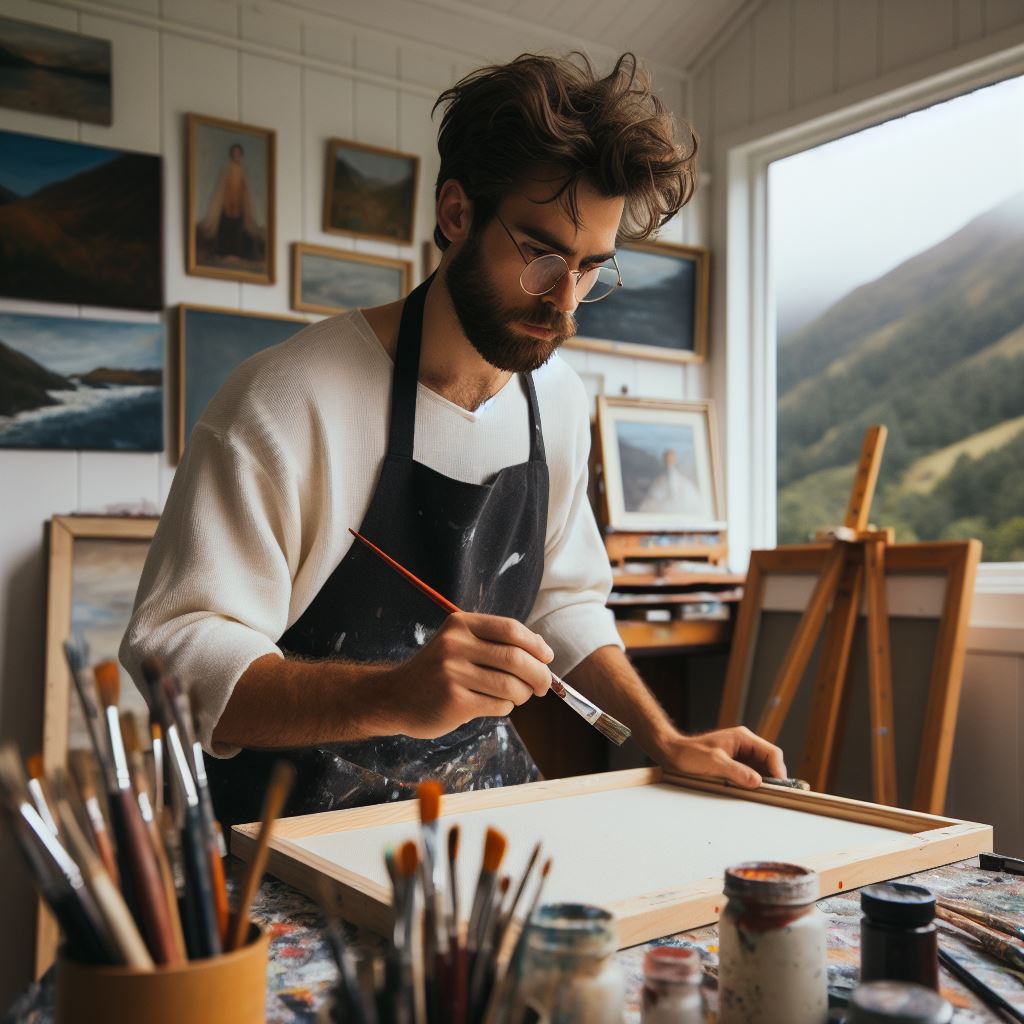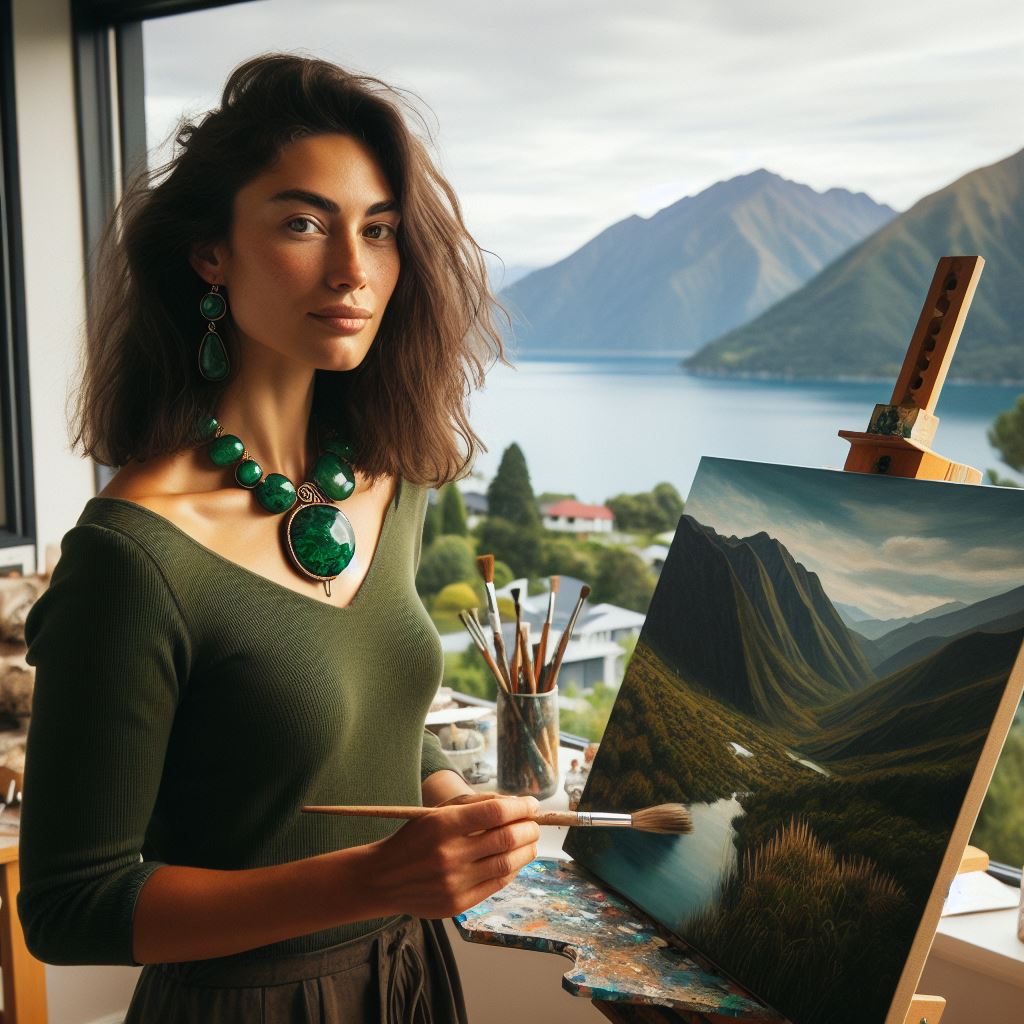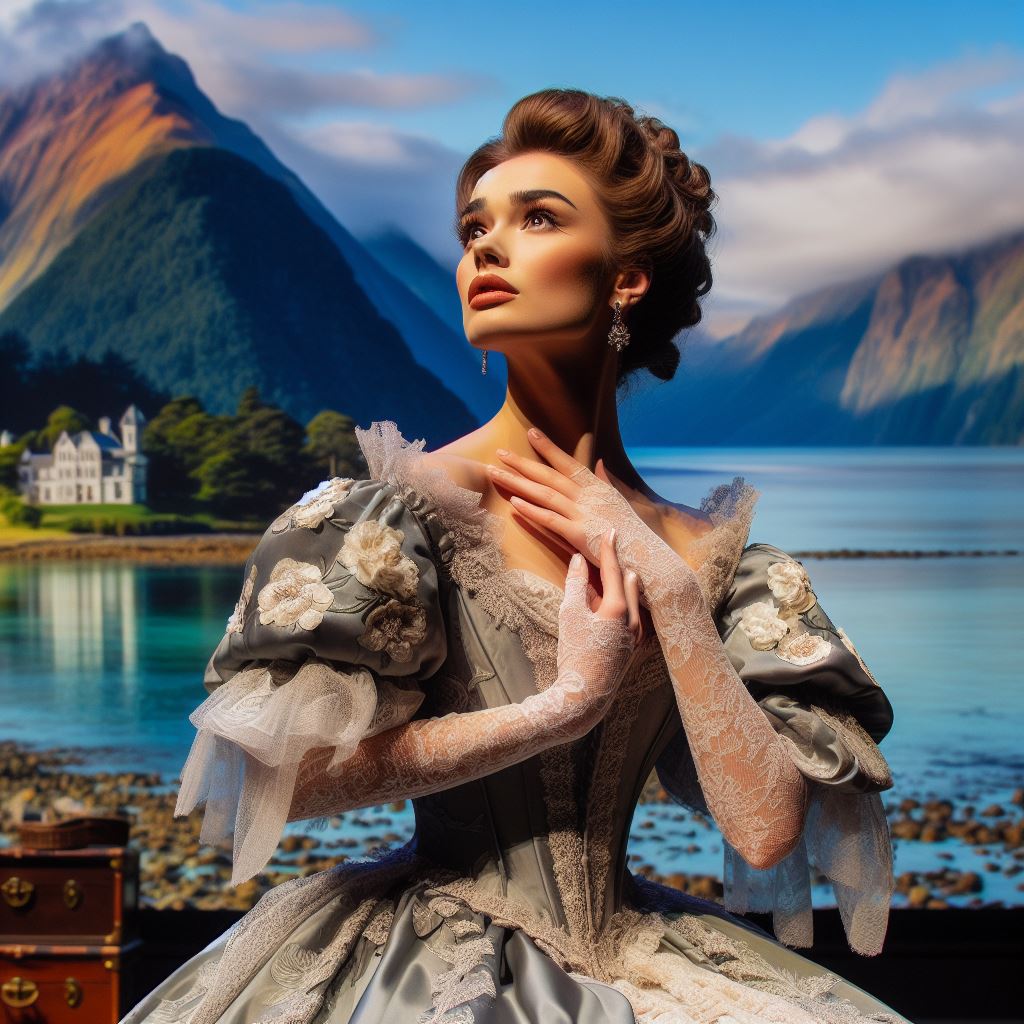Introduction
Discussing Fine Arts as a career option in New Zealand is significant and relevant.
This blog post provides a brief overview of this topic.
Fine Arts: A Career Journey in NZ
Fine Arts as a career option in New Zealand holds immense potential and opportunities.
This blog post explores the various aspects of this profession, offering a comprehensive guide for aspiring artists.
Embarking on a career in Fine Arts can be a dream come true for individuals passionate about creative expression.
New Zealand, with its rich artistic heritage and thriving arts scene, offers a stimulating environment for artists to flourish.
In this blog post, we delve into the significance and relevance of the Fine Arts industry in New Zealand.
We discuss the growing demand for artistic talent, the supportive infrastructure, and the diverse opportunities available.
Furthermore, we shed light on the benefits and challenges of pursuing a career in Fine Arts, highlighting the potential for personal and professional growth.
We also provide valuable insights into the necessary skills, qualifications, and avenues for career development within the industry.
With a focus on active learning and practical advice, this blog post aims to inspire and inform aspiring artists about the possibilities that await them in the world of Fine Arts in New Zealand.
Whether you are a seasoned artist or considering a career change, exploring Fine Arts in New Zealand can unlock a world of creativity and fulfillment.
Join us on this journey as we uncover the rewarding path of a Fine Arts career in this breathtaking country.
Overview of Fine Arts in New Zealand
Fine arts in New Zealand have a rich and diverse history with a strong cultural significance. The country’s artistic landscape is a reflection of its unique identity and creative spirit.
The importance of art in the country’s cultural landscape.
Art plays a vital role in New Zealand’s cultural fabric. It allows individuals to express their thoughts, emotions, and experiences in a visually compelling way.
This form of creative expression has become an integral part of the nation’s identity.
Notable artists and their contributions to the field.
Many notable artists have emerged from New Zealand, leaving a lasting impact on the field of fine arts. One such artist is Colin McCahon, known for his evocative landscapes and use of symbolism.
His artworks capture the essence of New Zealand’s natural beauty and its connection to spirituality.
Ralph Hotere is another renowned artist whose work explores themes of cultural identity and social justice.
Through his powerful installations and provocative paintings, Hotere challenges societal norms and raises important questions about New Zealand’s past and present.
Artistic Innovation in New Zealand: Pioneers and Opportunities
Another artist worth mentioning is Lisa Reihana, known for her groundbreaking video installation “in Pursuit of Venus [infected].”
This work reimagines historical European paintings and presents a more inclusive and accurate representation of New Zealand’s colonial history, giving voice to the indigenous Maori people.
These artists, among others, have significantly contributed to the field of fine arts in New Zealand.
Their works have not only provoked important conversations but have also inspired younger generations of artists to explore new artistic territories and push boundaries.
Furthermore, New Zealand provides a nurturing environment for aspiring artists.
The country’s art institutions and organizations offer a range of educational programs and opportunities for artists to develop their skills and showcase their work.
Personalized Career Consulting
Unlock your potential with expert career advice tailored to your goals. Get personalized guidance and actionable steps toward your dream career in New Zealand.
Get StartedNurturing Creativity: The Role of Creative New Zealand
The New Zealand Arts Council, also known as Creative New Zealand, plays a crucial role in supporting and promoting the arts in the country.
They provide funding and resources to artists, ensuring that they have the necessary support to thrive and contribute to New Zealand’s artistic landscape.
Moreover, exhibitions and art festivals are held throughout the country, allowing artists to exhibit their work to a wider audience.
These events not only celebrate New Zealand’s artistic talent but also provide a platform for artists to connect and collaborate with like-minded individuals.
In essence, fine arts in New Zealand are a flourishing and integral part of the country’s cultural heritage.
From celebrated artists who have made significant contributions to organizations that support aspiring artists, New Zealand’s artistic landscape continues to thrive and evolve.
Art will always hold a special place in New Zealand, capturing its essence and reflecting the diverse narratives of its people.
Read: NZ Bands Making Global Waves
Career Paths in Fine Arts
There are numerous career paths available in the field of Fine Arts. Below is an overview of diverse options:
Traditional Avenues
- Painting: Artists can specialize in various painting techniques including oil, watercolor, and acrylic.
- Sculpture: This involves creating three-dimensional artwork using materials like clay, wood, or metal.
- Ceramics: Artists can design and produce pottery, porcelain, and other ceramic pieces.
- Printmaking: This is the process of creating artworks by transferring images onto surfaces like paper or fabric.
- Drawing: Artists can excel in sketching, charcoal drawing, or using other drawing mediums.
Non-Traditional Paths
- Digital Arts: Artists can explore computer-based mediums such as digital painting, graphic design, and animation.
- Installation Art: This form involves creating immersive experiences or transforming spaces through artistic installations.
- Performance Art: Artists express their creativity through live performances, incorporating various elements like theater, music, and dance.
- Photography: Artists can specialize in capturing and manipulating images using traditional or digital photography techniques.
- Video Art: This involves creating visual artwork using video recordings, often combined with other art forms.
Diverse Paths: Navigating Careers in Fine Arts
These are just a few examples from the vast range of career paths available within the Fine Arts industry.
Each career path offers unique challenges and opportunities for artistic expression.
Artists can specialize in one particular medium or explore a combination of different mediums to enhance their artistic vision.
Regardless of the chosen career path, artists face the challenge of finding their unique artistic voice and developing their signature style.
They must constantly experiment, learn, and refine their skills to stay relevant in the ever-evolving art world.
Furthermore, pursuing a career in Fine Arts requires dedication, perseverance, and the willingness to take risks.
Success often comes through networking, exhibiting work, and building a strong portfolio.
Moreover, the career paths in Fine Arts are not limited to a traditional 9 to 5 job.
Many artists have the flexibility to work as freelancers or be self-employed, allowing them to have greater control over their artistic endeavors.
Diverse Opportunities: Career Paths in Fine Arts
Finally, the career paths in Fine Arts offer opportunities for personal and professional growth.
Artists can engage with different communities, collaborate with other creatives, and contribute to the cultural landscape of New Zealand.
In general, the world of Fine Arts offers diverse career paths that cater to various artistic interests and skills.
Whether it’s traditional avenues like painting and sculpture or non-traditional paths like digital arts and installation arts, there is a wide range of options for aspiring artists to explore and pursue their passion.
Read: Maori Music: NZ’s Rich Heritage
Transform Your Career with a Professional CV and Cover Letter
Stand out to employers with an ATS-optimized resume and tailored cover letter designed to match your dream role. Let us craft your job application materials for success!
Get StartedEducation and Training
Formal education plays a crucial role in the development of aspiring fine arts professionals. It provides the necessary foundation and skills needed to excel in this creative field.
Importance of Formal Education in Fine Arts
- Enhances artistic abilities: Formal education helps fine arts students refine their skills and expand their artistic capabilities.
- Develops critical thinking: Education in fine arts cultivates the ability to critically analyze and interpret various forms of artistic expression.
- Exposure to diverse techniques: Studying fine arts in an educational setting exposes students to a wide range of artistic techniques and styles.
- Networking opportunities: Educational institutions often provide opportunities for students to connect with industry professionals and fellow artists.
- Builds a strong portfolio: Fine arts programs help students create a portfolio that showcases their work, aiding them in securing future opportunities.
Notable Institutions Offering Fine Arts Programs in New Zealand
- University of Auckland’s Elam School of Fine Arts: Renowned for its comprehensive fine arts programs and experienced faculty.
- University of Canterbury School of Fine Arts: Offers a range of undergraduate and postgraduate fine arts degrees.
- Whitireia Community Polytechnic: Known for its practical and hands-on fine arts courses.
- Whitecliffe College of Arts and Design: Offers a diverse range of fine arts programs with a focus on individual artistic development.
- Wellington College of Arts: Known for its vibrant arts community and a wide range of fine arts courses.
Different Levels of Qualifications Achievable in the Field
In the field of fine arts, individuals can pursue various levels of qualifications, depending on their career goals and aspirations.
- Certificate and Diploma: These programs provide introductory knowledge and skills in fine arts.
- Bachelor’s Degree: A four-year undergraduate program that allows students to specialize in a specific area of fine arts.
- Master’s Degree: A postgraduate program that provides advanced knowledge and specialization in fine arts.
- Doctorate: A research-based program for those seeking to make significant contributions to the field through original research.
It is important for aspiring fine arts professionals to carefully consider their educational path and choose the level of qualification that aligns with their long-term career goals.
Regardless of the chosen level, formal education in fine arts equips individuals with the necessary skills, knowledge, and industry connections to thrive in their artistic journey.
Remember, education is the key that unlocks the door to limitless creative possibilities in the world of fine arts.
Read: NZ Music Festivals: Behind Scenes
Challenges and Opportunities in the Fine Arts Industry
Identifying the Challenges Faced by Aspiring Artists
- Financial instability is a common challenge for aspiring artists, as they often struggle to make a living from their art.
- Lack of recognition and exposure can make it difficult for artists to establish themselves in the industry.
- Negative societal perception of the arts as a viable career can discourage many talented individuals from pursuing their passion.
- The absence of a clear career path in the arts industry can leave artists feeling lost and uncertain about their future.
- Artists often face self-doubt and struggle with maintaining their motivation and inspiration in a competitive field.
The Competitive Nature of the Field and the Need for Perseverance
The fine arts industry is highly competitive, with countless artists vying for limited opportunities. In such a saturated market, perseverance is essential for success.
Artists must continuously hone their craft and push the boundaries of their creativity to stand out from the crowd.
They need to regularly create new work and showcase their talent in order to catch the attention of potential buyers, galleries, and art collectors.
Rejection is inevitable in the arts, and aspiring artists must have the resilience to bounce back from setbacks and learn from them.
It is through perseverance that artists can overcome challenges and make their mark in the industry.
Highlighting Opportunities: Grants, Residencies, and Art Festivals
Although the fine arts industry presents challenges, there are also numerous opportunities available to aspiring artists.
Grants and scholarships offered by various organizations and institutions provide financial support to artists, enabling them to pursue their creative endeavors without the burden of financial instability.
Residencies allow artists to work in a different environment, away from their usual surroundings, fostering creativity and new artistic perspectives.
These residencies often provide accommodation, studio space, and other resources necessary for the artists to focus on their work.
Art festivals bring together artists, collectors, and art enthusiasts in a vibrant celebration of creativity. They offer a platform for exposure and networking, allowing artists to connect with potential buyers and collaborators.
Navigating Challenges: Opportunities in the Fine Arts
Participating in art festivals can lead to opportunities such as commissions, gallery representation, and collaborations with other artists.
It is through these opportunities that artists can gain recognition and build a successful career in the fine arts industry.
In review, aspiring artists in the fine arts industry face various challenges, including financial instability, lack of recognition, negative societal perception, uncertainty, and self-doubt.
However, with perseverance and a proactive attitude, artists can overcome these challenges and make a name for themselves.
They can also take advantage of opportunities such as grants, residencies, and art festivals to propel their careers forward.
Despite the competitive nature of the field, the fine arts industry is rich with possibilities and rewards for those who are willing to put in the effort and dedication.
Boost Your Career with a Standout LinkedIn Profile
Attract recruiters and expand your network with a fully optimized LinkedIn profile tailored to highlight your strengths and professional goals. Let your profile open doors to new opportunities!
Get OptimizedRead: Women in NZ Music: Rising Stars

Success Stories: Inspiring Fine Art Careers in NZ
In the world of fine arts, there are talented individuals who have not only established themselves in the field but have also made significant contributions to the art community in New Zealand.
Their achievements and notable projects serve as a great inspiration for aspiring artists and offer valuable lessons that can be learned from their journeys.
Here, we delve into the success stories of some of these remarkable artists.
Sarah Thompson – Master of Portraits
Sarah Thompson, a renowned fine artist, has made a name for herself through her extraordinary talent in creating lifelike portraits.
Her keen attention to detail and ability to capture the essence of her subjects have earned her international recognition.
Thompson’s notable achievement includes a commissioned portrait of the Prime Minister, which hangs proudly in the national gallery.
Lessons to learn: Dedication, perseverance, and refining specialized skills can elevate an artist’s career to unparalleled heights.
Michael Reynolds – Capturing the Essence of Nature
Michael Reynolds, a landscape painter, has carved a niche for himself in the art world by capturing the stunning beauty of New Zealand’s landscapes.
His ability to evoke emotions through his vibrant and dynamic paintings has garnered him a dedicated following.
Reynolds has collaborated on several public art projects, bringing the natural wonders of NZ to city dwellers.
Lessons to learn: Finding one’s unique style and subject matter, combined with collaborations, can expand an artist’s reach and impact.
Emma Baker – The Visionary Sculptor
Emma Baker’s sculptures have taken the fine art world by storm. Her innovative use of materials and thought-provoking concepts have earned her accolades internationally.
One of her most notable projects was a collaboration with a prominent architectural firm to create a large-scale sculpture displayed in the heart of Auckland.
Baker’s work challenges societal norms and pushes the boundaries of traditional sculpture.
Lessons to learn: Embracing innovation, fearlessness, and experimentation can lead to groundbreaking works that make a lasting impact.
Jason Lee – Bridging Cultures through Art
Jason Lee, a multi-disciplinary artist, has become a prominent figure in the art community for his ability to bridge cultural gaps through his artwork.
His installations and paintings seamlessly blend elements from both Maori and European cultures, fostering understanding and dialogue.
Lee’s notable contribution includes a powerful exhibition exploring the history and impact of colonization in NZ.
Lessons to learn: Art has the power to create connections, heal wounds, and provoke important conversations about social and cultural issues.
Rebecca Mitchell – Pushing Boundaries with Digital Art
Rebecca Mitchell, a digital artist, has created a buzz in the art world with her boundary-pushing work.
Her intricate and mesmerizing digital art pieces have gained recognition both nationally and internationally.
Mitchell’s notable achievement includes a collaboration with a renowned fashion brand, where her artwork was featured in a major advertising campaign.
Lessons to learn: Embracing technology and exploring new mediums can lead to innovative artworks and open up exciting opportunities for artists.
These success stories showcase the incredible talent and imagination that exists within the fine arts community in New Zealand.
They serve as an inspiration to aspiring artists and demonstrate that with dedication, unique perspectives, and a willingness to push boundaries, a fulfilling and successful career in the fine arts is indeed possible.
Supporting and Nurturing the Fine Arts Industry in NZ
Importance of Supporting and Nurturing the Fine Arts Industry
- Supporting and nurturing the Fine Arts industry in NZ is crucial for its growth and development.
- It helps to preserve cultural heritage and promote artistic expression within the community.
- By supporting the Fine Arts industry, we encourage creativity, innovation, and diversity in artistic practices.
- Investing in the Fine Arts industry leads to economic benefits as it attracts tourism and generates revenue.
- Nurturing the Fine Arts industry ensures that artists have a platform to showcase their talents and ideas.
- It fosters a sense of pride and identity among local artists and enriches the cultural fabric of NZ.
Initiatives and Organizations Promoting Local Artists
- The Arts Foundation of New Zealand is dedicated to supporting and promoting the arts and artists.
- Toi Māori Aotearoa nurtures and promotes traditional and contemporary Māori arts.
- Creative New Zealand provides funding and resources to artists and arts organizations in NZ.
- The New Zealand Music Commission supports and promotes the local music industry.
- City and regional councils often have initiatives and programs to support local artists and cultural events.
Grants, Scholarships, and Mentorship Programs Available
There are several grants, scholarships, and mentorship programs available to support and encourage artists in NZ:
- The Creative New Zealand grants offer funding for various arts disciplines and projects.
- Te Waka Toi grants support Māori artists and support their artistic endeavors.
- The New Zealand Arts Foundation awards scholarships to artists across different creative fields.
- The Prime Minister’s Excellence Awards for Tertiary Dance and Drama support emerging talented artists.
- The Artists Alliance provides mentorship and professional development opportunities for visual artists.
In short, supporting and nurturing the Fine Arts industry in NZ is vital for its growth, cultural preservation, and economic prosperity.
Through initiatives and organizations, local artists receive the necessary encouragement and exposure to showcase their work.
Additionally, grants, scholarships, and mentorship programs provide vital support and resources to emerging and established artists.
By investing in the Fine Arts industry, we contribute to the overall social and cultural well-being of NZ.
Conclusion
This blog section has explored the journey of pursuing a career in Fine Arts in NZ. We have discussed the importance of passion and dedication in this field.
Throughout the post, we highlighted the various opportunities available in the Fine Arts industry, from visual arts to performing arts.
We also touched upon the challenges that individuals may face, such as financial instability and the need for continuous learning and improvement.
If you are considering a career in Fine Arts in NZ, we encourage you to follow your passion and explore the numerous avenues available to you.
Whether you choose to become a painter, a dancer, or an actor, your contribution to the art community is significant and can inspire others.
Remember, the essence of Fine Arts lies in pursuing what you love, expressing yourself, and contributing to the artistic dialogue in society.
It is not just about making a living, but also about making a difference.
So take that leap of faith, hone your skills, and immerse yourself in the vibrant and diverse world of Fine Arts in NZ.
Your unique talents and creative perspective have the potential to shape the future of art and inspire generations to come.
Lastly, embrace your passion, pursue your dreams, and become a part of the ever-evolving and enriching Fine Arts community in NZ.
Your contribution is invaluable, and your journey is bound to be a fulfilling and rewarding one.




